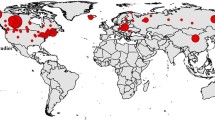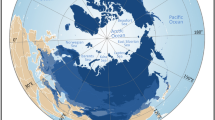Abstract
Ice jams are impacted by several climatic factors that are likely to change under a future warming climate. Due to the complexity of river ice phenology, projection of future ice jams is challenging. However, it is important to be able to project future ice jam behavior. Additionally, ice jam research is limited by the shortage of long-term monitoring data. In this paper, a novel framework for projecting future ice jam behavior is developed and implemented for ice jams in a data-sparse region, the Slave River Delta, NWT, Canada, situated in the Mackenzie River Basin (MRB). This framework employs both historical records and future hydro-meteorological data, acquired from climate and hydrological models, to drive the river ice models and quantify climate-induced influences on ice jams. Ice jam behavior analysis is based on three outputs of the framework: potential of river ice jamming, ice jam initiation date, and the stage frequency distribution of backwater elevation induced by ice jams. Trends of later ice jam initiation and decreased possibility of ice jam formation are projected, but ice jamming events in the Slave River Delta are likely to be more severe and cause higher backwater levels.










Similar content being viewed by others
Availability of data and materials
There is one supplemental data section.
References
Ashton GD (2011) River and lake ice thickening, thinning, and snow ice formation. Cold Reg Sci Technol 68(1-2):3–19
Asong ZE, Elshamy M, Princz D, Wheater H, Pomeroy JW, Pietroniro A, Cannon A (2020) High-resolution meteorological forcing data for hydrological modelling and climate change impact analysis in the Mackenzie river basin. Earth Syst Sci Data 12:1
Beltaos S (1997) Onset of river ice breakup. Cold Reg Sci Technol 25(3):183–196
Beltaos S, Prowse T (2001) Climate impacts on extreme ice-jam events in Canadian rivers. Hydrol Sci J 46(1):157–181
Beltaos S, Prowse T, Carter T (2006) Ice regime of the lower Peace River and ice-jam flooding of the Peace-Athabasca Delta. Hydrol Process: Int J 20 (19):4009–4029
Brock B, Wolfe B, Edwards T (2008) Spatial and temporal perspectives on spring break-up flooding in the Slave River Delta, NWT. Hydrol Process: Int J 22(20):4058–4072
Brown DR, Brinkman TJ, Verbyla DL, Brown CL, Cold HS, Hollingsworth TN (2018) Changing river ice seasonality and impacts on interior Alaskan communities. Weath Clim Soc 10(4):625–640
Burn DH (2008) Climatic influences on streamflow timing in the headwaters of the Mackenzie River Basin. J Hydrol 352(1-2):225–238
Carson R, Beltaos S, Groeneveld J, Healy D, She Y, Malenchak J, Morris M, Saucet J. -P., Kolerski T, Shen HT (2011) Comparative testing of numerical models of river ice jams. Can J Civ Eng 38(6):669–678
Cook J, Oreskes N, Doran PT, Anderegg WR, Verheggen B, Maibach EW, Carlton JS, Lewandowsky S, Skuce AG, Green SA et al (2016) Consensus on consensus: a synthesis of consensus estimates on human-caused global warming. Environ Res Lett 11(4):048002(1)–048002(7)
Côté J, Gravel S, Méthot A, Patoine A, Roch M, Staniforth A (1998) The operational CMC–MRB global environmental multiscale (GEM) model. Part I: design considerations and formulation. Mon Weather Rev 126(6):1373–1395
English MC, Hill RB, Stone MA, Ormson R (1997) Geomorphological and botanical change on the outer Slave River Delta, NWT, before and after impoundment of the Peace River. Hydrol Process 11(13):1707–1724
Gagnon AS, Gough WA (2005) Trends in the dates of ice freeze-up and breakup over Hudson Bay, Canada. Arctic 58:370–382
Gibson J, Prowse T, Peters D (2006) Partitioning impacts of climate and regulation on water level variability in great slave lake. J Hydrol 329 (1–2):196–206
Guo Q (2002) Applicability of criterion for onset of river ice breakup. J Hydraul Eng 128(11):1023–1026
Hicks F (2009) An overview of river ice problems: CRIPE07 guest editorial. Cold Reg Sci Technol 55(2):175–185
Hosking JRM, Wallis JR, Wood EF (1985) Estimation of the generalized extreme-value distribution by the method of probability-weighted moments. Technometrics 27(3):251–261
Huntington TG, Hodgkins G, Dudley R (2003) Historical trend in river ice thickness and coherence in hydroclimatological trends in Maine. Clim Change 61(1–2):217–236
Kouwen N (1988) WATFLOOD: a micro-computer based flood forecasting system based on real-time weather radar. Canad Water Resour J 13(1):62–77
Leconte R, Peters D, Pietroniro A, Prowse T (2006) Modelling climate change impacts in the Peace and Athabasca Catchment and delta: II—variations in flow and water levels with varying winter severity. Hydrol Process: Int J 20 (19):4215–4230
Lespinas F, Fortin V, Roy G, Rasmussen P, Stadnyk T (2015) Performance evaluation of the Canadian precipitation analysis (CaPA). J Hydrometeorol 16(5):2045–2064
Lindenschmidt K, Rokaya P (2019) A stochastic hydraulic modelling approach to determining the probable maximum staging of ice-jam floods. J Environ Inform 34:1
Lindenschmidt K-E (2017) RIVICE—a non-proprietary, open-source, one-dimensional river-ice model. Water 9(5):314(1)–314(15)
Lindenschmidt K-E (2020) River ice processes and ice flood forecasting
Lindenschmidt K-E, Das A, Rokaya P, Chun K, Chu T (2015) Ice jam flood hazard assessment and mapping of the Peace River at the Town of Peace River. In: 18th Workshop on the Hydraulics of Ice Covered Rivers, Quebec City, Canada, pp 18–21
Lindenschmidt K-E, Rokaya P, Das A, Li Z, Richard D (2019) A novel stochastic modelling approach for operational real-time ice-jam flood forecasting. J Hydrol 575:381–394
Magnuson JJ, Robertson DM, Benson BJ, Wynne RH, Livingstone DM, Arai T, Assel RA, Barry RG, Card V, Kuusisto E et al (2000) Historical trends in lake and river ice cover in the Northern hemisphere. Science 289 (5485):1743–1746
Morrison JE, Smith JA (2002) Stochastic modeling of flood peaks using the generalized extreme value distribution. Water Resour Res 38(12):41–1
Nyaupane N, Mote SR, Bhandari M, Kalra A, Ahmad S (2018) Rainfall-runoff simulation using climate change based precipitation prediction in HEC-HMS model for Irwin Creek, Charlotte, North Carolina. In: World Environmental and Water Resources Congress, vol 2018, pp 352–363
Pietroniro A, Fortin V, Kouwen N, Neal C, Turcotte R, Davison B, Verseghy D, Soulis E, Caldwell R, Evora N et al (2007) Development of the MESH modelling system for hydrological ensemble forecasting of the Laurentian Great Lakes at the regional scale. Hydrol Earth Syst Sci Discuss 11(4):1279–1294
Pietroniro A, Leconte R, Toth B, Peters DL, Kouwen N, Conly F, Prowse T (2006) Modelling climate change impacts in the Peace and Athabasca catchment and delta: III—integrated model assessment. Hydrol Process: Int J 20(19):4231–4245
Prowse T, Conly F (1998) Effects of climatic variability and flow regulation on ice-jam flooding of a northern delta. Hydrol Process 12(10-11):1589–1610
Prowse T, Beltaos S (2002) Climatic control of river-ice hydrology: a review. Hydrol Process 16(4):805–822
Prowse T, Bonsal BR, Lacroix MP, Beltaos S (2002) Trends in river-ice breakup and related temperature controls. In: Ice in the environment. 16th IAHR International Symposium on Ice, vol 3, pp 64–71
Sanderson Juanetta, Czarnecki A, Faria D (2012) Water and Suspended Sediment Quality of the Transboundary Reach of the Slave River, Northwest Territories. Water Resources Division Renewable Resources and Environment Directorate. Aboriginal Affairs and Northern Development Canada, NWT Region
Scinocca J, Kharin V, Jiao Y, Qian M, Lazare M, Solheim L, Flato G, Biner S, Desgagne M, Dugas B (2016) Coordinated global and regional climate modeling. J Climate 29(1):17–35
Shen H, Jayasundara N, Tuthill A, Mihm J, Frankenstein G (2005) Frequency and severity of past ice jams on the Grass River. (Report No. 03-18)
Shen HT, Liu L (2003) Shokotsu River ice jam formation. Cold Reg Sci Technol 37(1):35–49
Sun W, Trevor B (2018) A stacking ensemble learning framework for annual river ice breakup dates. J Hydrol 561:636–650
Thompson SA (1999) Hydrology for water management. Taylor & Francis Group
Toth B, Pietroniro A, Conly F, Kouwen N (2006) Modelling climate change impacts in the Peace and Athabasca catchment and delta: I—hydrological model application. Hydrol Process: Int J 20(19):4197–4214
Weedon GP, Balsamo G, Bellouin N, Gomes S, Best MJ, Viterbo P (2014) The WFDEI meteorological forcing data set: WATCH Forcing Data methodology applied to ERA-Interim reanalysis data. Water Resour Res 50(9):7505–7514
Whan K, Zwiers F (2016) Evaluation of extreme rainfall and temperature over North America in CanRCM4 and CRCM5. Climate Dynam 46 (11–12):3821–3843
Yassin F, Razavi S, Elshamy M, Davison B, Sapriza-Azuri G, Wheater H (2019) Representation and improved parameterization of reservoir operation in hydrological and land-surface models. Hydrol Earth Syst Sci 23(9):3735–3764
Zhang F, Li Z, Lindenschmidt K-E (2019) Potential of RADARSAT-2 to improve ice thickness calculations in remote, poorly accessible areas: a case study on the Slave River, Canada. Can J Remote Sens 45:1–12
Zhang F, Mosaffa M, Chu T, Lindenschmidt K-E (2017) Using remote sensing data to parameterize ice jam modeling for a Northern Inland Delta. Water 9(5):306(1)–306(18)
Funding
This research is supported by the Natural Sciences and Engineering Research Council of Canada (NSERC), Global Water Future (GWF) at the University of Saskatchewan, China Scholarship Council (CSC) and Canada Excellence Research Chair (CERC) Programme in Water Security.
Author information
Authors and Affiliations
Contributions
Fan Zhang proposed the main framework developed in this manuscript, ran the hydraulic simulations, processed model output data, and wrote the manuscript. Mohamed Elshamy pre-processed the climate change data, ran the hydrological simulations, and revised the manuscript. Karl-Erich Lindenschmidt proposed the initial idea of this research and revised the manuscript.
Corresponding author
Ethics declarations
Ethics approval
There are no ethical issues associated with this research.
Consent to participate
This research does not involve in investigating people who need to consent to participate.
Consent for publication
The authors consent the publisher to publish this work after being accepted.
Competing interests
The authors declare no competing interests.
Additional information
Publisher’s note
Springer Nature remains neutral with regard to jurisdictional claims in published maps and institutional affiliations.
Electronic supplementary material
Below is the link to the electronic supplementary material.
Rights and permissions
About this article
Cite this article
Zhang, F., Elshamy, M. & Lindenschmidt, KE. Climate change impacts on ice jam behavior in an inland delta: a new ice jam projection framework. Climatic Change 171, 13 (2022). https://doi.org/10.1007/s10584-022-03312-3
Received:
Accepted:
Published:
DOI: https://doi.org/10.1007/s10584-022-03312-3




